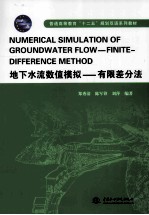

地下水流数值模拟 有限差分法PDF电子书下载
- 电子书积分:8 积分如何计算积分?
- 作 者:郑秀清,陈军锋,刘萍编著
- 出 版 社:北京:中国水利水电出版社
- 出版年份:2014
- ISBN:9787517017844
- 页数:119 页
Chapter 1 Introduction 1
1.1 Brief of Groundwater 1
1.1.1 Importance of Groundwater 1
1.1.2 Groundwater Resources Management 2
1.2 Process of Groundwater Modeling 3
Chapter 2 Mathematical Model of Groundwater Flow 9
2.1 Basic Concepts 9
2.2 Basic Law 12
2.2.1 Law of Energy Conservation 12
2.2.2 Law of Mass Conservation 17
2.3 Basic Equation of Groundwater Flow 18
2.3.1 Basic Equation for Steady Incompressible Flow 18
2.3.2 Basic Equation for Non-steady Compressible Flow 19
2.4 Boundary Conditions 21
2.4.1 Boundary Conditions 21
2.4.2 Initial Conditions 22
2.5 Mathematical Model 23
Chapter 3 Numerical Method—Finite-Difference Method 24
3.1 Main Ideas and Solving Steps 24
3.1.1 Main Ideas of Finite-Difference Method 24
3.1.2 Steps of Solving Groundwater Flow Problem by Difference Method 24
3.2 Finite Difference Formulae 25
3.2.1 Finite Difference Approximation 25
3.2.2 Convergence and Stability 27
3.3 Steady Flow in Confined Aquifers 27
3.3.1 1-D Steady Flow 27
3.3.2 2-D Steady Flow 34
3.4 Transient Flow in Confined Aquifers 37
3.4.1 1-D Transient Flow 37
3.4.2 2-D Transient Flow 40
3.5 Transient Flow in Unconfined Aquifers 44
Chapter 4 Introduction and Tutorial of Visual MODFLOW 48
4.1 Introduction of Visual MODFLOW 48
4.1.1 Brief Introduction of Visual MODFLOW 48
4.1.2 About the Interface 48
4.1.3 Main Menu Screen 49
4.1.4 Screen Layout 49
4.2 Instructions of Example Model 50
4.3 Creating and Defining a Flow Model 52
4.3.1 Generating a New Model 52
4.3.2 Refining the Model Grid 55
4.3.3 Adding Wells 62
4.3.4 Assigning Model Properties 63
4.3.5 Assigning Model Boundary Condition 68
4.3.6 Assigning Particles 73
4.4 Running Visual MODFLOW 74
4.4.1 Run Options for Flow Simulations 74
4.4.2 Engines to Run 75
4.5 Output Visualization 76
4.5.1 Head and Contouring Options 76
4.5.2 Velocity Vectors and Contouring Options 78
4.5.3 Pathlines and Pathline Options 80
Chapter 5 Numerical Simulation of Impervious Wall Construction of Xizhang Basin Groundwater Reservoir in Taiyuan 83
5.1 Model Objectives 83
5.2 Overviews of the Xizhang Basin 83
5.2.1 Regional Geography 83
5.2.2 Regional Geological and Hydrogeological Conditions 85
5.2.3 Social and Economic Situation 86
5.3 Conditions for the Construction of Underground Reservoir 86
5.4 Groundwater Flow Model for Xizhang Basin 87
5.4.1 Hydrogeological Conceptual Model 87
5.4.2 Establishment Groundwater Model 88
5.4.3 Identification and Calibration of the Model 92
5.5 Influences of Impervious Wall on Groundwater Flow 98
5.5.1 Input Data for Wall Boundary 98
5.5.2 Simulation Impervious Wall by Wall Boundary 98
5.5.3 Correction of Impervious Wall Parameters 98
5.5.4 Effects of Impervious Wall Construction on the Simulation of Groundwater Flow 99
Chapter 6 Application of MODPATH to Classify Protection Area in Tumen 106
6.1 Model Objectives 106
6.2 Overviews of Water Source Situation in Tumen 106
6.2.1 Geography 106
6.2.2 Regional Geological and Hydrogeological Conditions 108
6.3 Groundwater Flow Model for Tumen Water Source Area 109
6.3.1 Hydrogeological Conceptual Model 109
6.3.2 Mathematical Model for the Groundwater Flow 109
6.3.3 Model Validation 111
6.4 Delineation of Water Source Protection Zones by MODPATH 113
6.4.1 Numerical Simulation Method 113
6.4.2 Procedure of Protection Zones Delineation 114
6.4.3 Results of Protection Zones Delineation 114
References 119
- 《FDS火灾数值模拟》李胜利,李孝斌编著 2019
- 《强度理论与数值极限分析》郑颖人,孔亮,阿比尔的著 2020
- 《数值天气预报的数学物理基础 第1卷》曾庆存 2019
- 《燃烧后二氧化碳捕捉技术流场数值模拟》杨丽,刘方著 2018
- 《复合材料随机多尺度分析数值方法与工程应用》文聘 2019
- 《舰船结构爆炸毁伤分析数值仿真与试验》吴卫国 2019
- 《海洋动力环境模拟数值算法及应用》王永学 2019
- 《地表水环境数值模拟与预测 EFDC建模技术及案例实训》李一平,龚然,(美)保罗·克雷格著 2019
- 《FLAC3D数值模拟方法及工程应用》王涛编著 2019
- 《开源CAE数值仿真模拟软件介绍与应用》田春来著 2018
- 《市政工程基础》杨岚编著 2009
- 《家畜百宝 猪、牛、羊、鸡的综合利用》山西省商业厅组织技术处编著 1959
- 《《道德经》200句》崇贤书院编著 2018
- 《高级英语阅读与听说教程》刘秀梅编著 2019
- 《计算机网络与通信基础》谢雨飞,田启川编著 2019
- 《看图自学吉他弹唱教程》陈飞编著 2019
- 《法语词汇认知联想记忆法》刘莲编著 2020
- 《培智学校义务教育实验教科书教师教学用书 生活适应 二年级 上》人民教育出版社,课程教材研究所,特殊教育课程教材研究中心编著 2019
- 《国家社科基金项目申报规范 技巧与案例 第3版 2020》文传浩,夏宇编著 2019
- 《流体力学》张扬军,彭杰,诸葛伟林编著 2019
- 《中国当代乡土小说文库 本乡本土》(中国)刘玉堂 2019
- 《异质性条件下技术创新最优市场结构研究 以中国高技术产业为例》千慧雄 2019
- 《中国铁路人 第三届现实主义网络文学征文大赛一等奖》恒传录著 2019
- 《莼江曲谱 2 中国昆曲博物馆藏稀见昆剧手抄曲谱汇编之一》郭腊梅主编;孙伊婷副主编;孙文明,孙伊婷编委;中国昆曲博物馆编 2018
- 《中国制造业绿色供应链发展研究报告》中国电子信息产业发展研究院 2019
- 《中央财政支持提升专业服务产业发展能力项目水利工程专业课程建设成果 设施农业工程技术》赵英编 2018
- 《中国陈设艺术史》赵囡囡著 2019
- 《指向核心素养 北京十一学校名师教学设计 英语 七年级 上 配人教版》周志英总主编 2019
- 《《走近科学》精选丛书 中国UFO悬案调查》郭之文 2019
- 《清至民国中国西北戏剧经典唱段汇辑 第8卷》孔令纪 2018
